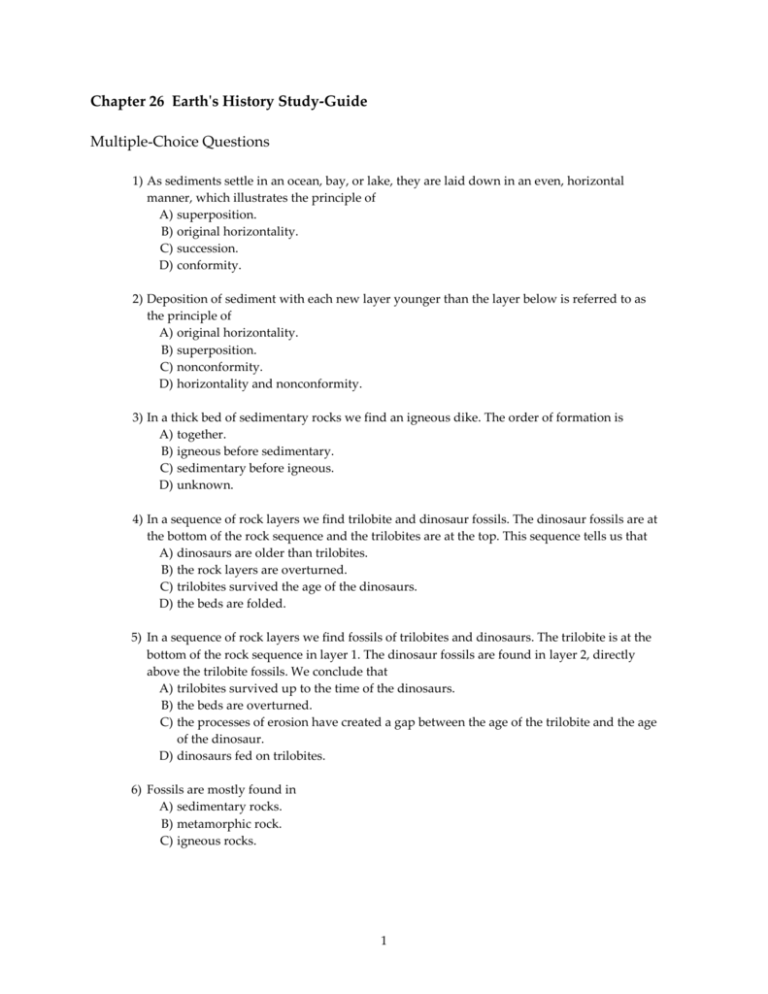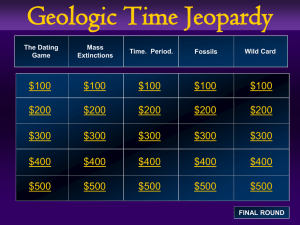Chapter 26 Earth`s History Study-Guide Multiple
advertisement

Chapter 26 Earth's History Study-Guide Multiple-Choice Questions 1) As sediments settle in an ocean, bay, or lake, they are laid down in an even, horizontal manner, which illustrates the principle of A) superposition. B) original horizontality. C) succession. D) conformity. 2) Deposition of sediment with each new layer younger than the layer below is referred to as the principle of A) original horizontality. B) superposition. C) nonconformity. D) horizontality and nonconformity. 3) In a thick bed of sedimentary rocks we find an igneous dike. The order of formation is A) together. B) igneous before sedimentary. C) sedimentary before igneous. D) unknown. 4) In a sequence of rock layers we find trilobite and dinosaur fossils. The dinosaur fossils are at the bottom of the rock sequence and the trilobites are at the top. This sequence tells us that A) dinosaurs are older than trilobites. B) the rock layers are overturned. C) trilobites survived the age of the dinosaurs. D) the beds are folded. 5) In a sequence of rock layers we find fossils of trilobites and dinosaurs. The trilobite is at the bottom of the rock sequence in layer 1. The dinosaur fossils are found in layer 2, directly above the trilobite fossils. We conclude that A) trilobites survived up to the time of the dinosaurs. B) the beds are overturned. C) the processes of erosion have created a gap between the age of the trilobite and the age of the dinosaur. D) dinosaurs fed on trilobites. 6) Fossils are mostly found in A) sedimentary rocks. B) metamorphic rock. C) igneous rocks. 1 7) In a sequence of rock layers we find fossils of trilobites and dinosaurs. The trilobites are found at the bottom of the rock sequence in layer 1. The dinosaur fossils are found in layer 2, directly above the trilobite fossils. There are inclusions of trilobite fossils in layer 2. We conclude that A) dinosaurs were extinct long before trilobites came into existence. B) dinosaurs are from the Cambrian Period. C) by inclusion and faunal succession, layer 1 is older than layer 2. D) there is no time gap between the rocks. 8) The principle of superposition states that the top layer of rock is A) igneous. B) the youngest. C) sedimentary. D) the oldest. 9) An idea that the earth processes occurring today have always occurred is the A) principle of superposition. B) theory of uniformitarianism. C) principle of original horizontality. D) theory of unconformity. 10) An eroded surface between rocks that represents a gap in Earth history is A) called a dike. B) an unconformity. C) a faunal conformity. D) none of the above 11) The scientific principle that assumes that the different forms of animals throughout Earth's past occurred in a definite order is called the principle of A) fossil assemblage. B) faunal succession. C) conformable fossils. D) fossil determination. 12) An unconformity can be interpreted as A) an occurrence of radioactive decay. B) repeated intrusions of igneous rock. C) a gap in the rock record. D) the result of repeated volcanic action. 13) Conditions for the preservation of fossils are best achieved A) in desert environments. B) in glaciated environments. C) in shallow river beds. D) on the floors of shallow seas. 2 14) In any sequence of sedimentary rock layers that have not been subjected to stress, you would expect to find A) horizontal layers. B) older layers at the bottom and younger layers at the top. C) fossils in the bottom layers and inclusions in the upper layers. D) both A and B 15) Investigating Earth's history of rock layers is made possible by the application of the principle of A) cross-cutting relationships. B) faunal succession. C) superposition. D) all of the above 16) The idea that the principles of physics, chemistry, and geology have operated unchanged through time to shape Earth as we know it today is embodied in the principle of A) evolution. B) everlasting change. C) uniformitarianism. D) natural history. 17) The rather simple idea that, unless disturbed, younger sedimentary layers overlie older layers, is referred to as the principle of A) original horizontality. B) uniformitarianism. C) faunal succession. D) superposition. 18) According to most estimates, Earth is approximately A) 4.5 thousand years old. B) 4.5 million years old. C) 4.5 billion years old. D) 4.5 trillion years old. 19) In a sedimentary rock that contains inclusions of metamorphic rock, the inclusions must be A) older than the sedimentary rock. B) younger than the sedimentary rock. C) on top of the sedimentary rock. D) below the sedimentary rock. 20) Radiometric dating is based on A) decay of uranium-238 to lead-206. B) sequence of rocks and the relative position of one layer to another. C) proportions of radioactive isotopes and their decay products. D) the half-life of radioactive atoms. 3 21) To date relatively young rocks and materials, scientists use the decay of A) uranium-238 to lead-206. B) potassium-40 to argon-40. C) carbon-14 to nitrogen-14. D) uranium-235 to lead-207. 22) The time required for one-half of a radioactive material to decay is called the A) absolute age. B) half-life. C) date age. D) true-life. 23) To date the age of old rocks, which parent isotopes are most useful? A) uranium-235 and uranium-238 B) lead-207 and lead-206 C) potassium-40 to argon-40 24) Radiometric dating is based on the fact that, once a mineral has crystallized, any daughter product results only from the decay of the original unstable parent. Some complications are A) variations in temperature. B) failure to take samples too close together. C) that after metamorphism the mineral's "time clock" will be reset. Also weathering and escape of argon gas lead to false age estimation. D) a poorly maintained teleometer. 25) The ultimate truth of any radiometric date depends on the A) size of the given sample. B) chemical composition of the sample being tested. C) precision and accuracy of the lab techniques. D) reset date of the sample. 26) Earth's age has been determined to be A) 3.3 billion years old by using fossils. B) 4.5 billion years old by using sediment thickness. C) 3.8 billion years old by using rocks found in Greenland. D) 4.5 billion years old by using meteorites. 27) The process wherein an element changes spontaneously into a different element by changes in the nucleus of an atom is called A) radiometric dating. B) radioactive decay. C) radiometric decay. D) none of the above 4 28) The oldest rocks that have been dated by radioactivity are approximately A) 2 million years old. B) 200 million years old. C) 4 billion years old. D) 10 billion years old. 29) Radiocarbon dating is limited to the remains of plants and animals that died no longer than about A) 100 years ago. B) 5700 years ago. C) 40,000 years ago. D) 1,000,000 years ago. 30) If you wished to date a rock thought to be many millions of years old, which of the following would be the least useful? A) uranium-lead method B) potassium-argon method C) carbon-14 method 31) If a radioactive element has a half-life of 704 million years, and the amount of parent material remaining is one-eighth of the original amount of parent material, the specimen is A) 2,112,000,000 years old. B) 1,408,000,000 years old. C) 2,816,000,000 years old. D) 3,520,000,000 years old. 32) If the half-life of some radioactive element is 1 billion years, and a mass of rock originally contained 100 g of that element, how many grams of the radioactive element would be left after three billion years had passed? A) 6.25 g B) 12.5 g C) 25 g D) 50 g E) none 33) The numerical dates associated with events on the geologic time scale were determined by A) relative dating. B) radioactive dating. C) radiometric dating. D) fossil assemblages through time. 34) The isotope most useful for dating rocks from the late Pleistocene is A) uranium-238. B) uranium-235. C) potassium-40. D) carbon-14. 5 35) Granitic pebbles with a radiometric age of 300 million years are embedded in a sedimentary rock. A dike, dated at 200 million years, intrudes into the sedimentary rock. With all this information we can estimate the age of the sedimentary rock to be A) older than 300 million years. B) younger than 200 million years. C) between 200 and 300 million years old. D) precisely 300 million years old. 36) The resetting of a mineral's time clock means that A) a mineral can be formed and reformed again and again. B) the date obtained from a mineral that has undergone metamorphism will be the date of the metamorphic event, not the date of the rock's formation. C) the date obtained from a mineral that has undergone metamorphism will be the date of the rock's formation, not the date of the metamorphic event. D) minerals can tell time just like a clock can tell time. 37) The Precambrian witnessed the development of A) the first atmosphere. B) the ozone layer. C) photosynthesis. D) all of the above 38) Life forms in the Precambrian include A) trilobites, brachiopods, and stromatolites. B) cyanobacteria and trilobites. C) the agnatha and the coelacanths. D) stromatolites and certain blue-green algae. 39) The fossil record is the record of former life forms as preserved in Earth's rocks. Which of the following is not representative of the fossil record? A) The fossil record spans 3 billion years of Earth's 4.6 billion year age. B) The most common fossils are those organisms that had hard parts like shells and bones. C) The first fossils were simple, anaerobic algal plants; these fossil plants are similar to present day stromatolites. D) The Paleozoic era is credited with the emergence of life. 40) Key events for the Precambrian, which makes up the majority of Earth's history, are A) formation of Earth with widespread volcanic activity and meteorite bombardment. B) cooling and formation of continental plates. C) primitive photosynthesis, free oxygen, and primordial life forms. D) all of the above 41) The oldest known fossils are A) trilobites and brachiopods. B) algae and bacteria. C) fungi and algae. D) worms and jellyfish. 6 42) During the Precambrian, the development of the ozone layer helped A) primitive organisms on Earth's surface to nucleate. B) to shield Earth's surface from harmful ultraviolet radiation. C) promote the emergence of stromatolites. D) promote the development of anaerobic organisms. 43) You would expect to find the least number of fossils in rocks from the A) Cenozoic era. B) Mesozoic era. C) Paleozoic era. D) Precambrian era. 44) Development of Earth's early oceans was likely due to A) water-rich meteors bombarding Earth's surface. B) volcanic outgassing in Precambrian time. C) intense convection in the mantle, and severe heat dissipation from Earth's interior. D) volcanic outgassing in the early Paleozoic. 45) The Paleozoic is noted for several worldwide rises in sea level. Which of the following is not a representative factor for sea level rise in the Paleozoic? A) A divergent boundary between the North American and European Plate contributed to active seafloor spreading. B) Ocean basins stood high on the asthenosphere due to active seafloor spreading. C) Ocean basins stood high on the asthenosphere due to slow but continuous seafloor convergence. D) the breakup of the Precambrian supercontinent 46) The Paleozoic era begins with the Cambrian and concludes with the A) Ordovician period. B) Silurian period. C) Permian period. D) Triassic period. 47) A significant biological event during the Cambrian period was the A) emergence of the fishes. B) evolution of the outer skeleton. C) emergence of the trilobite. D) development of lungs in fishes. 48) The Ordovician period is most noted for the A) emergence of the fishes. B) great diversity in marine life. C) lobe-finned fishes. D) extinction of the trilobite. 7 49) The Devonian period is most noted for the A) ability of certain fishes to breath air. B) ability of certain fishes to move onto land. C) first amphibians. D) all of the above 50) During the Carboniferous period, warm climatic conditions favored the development of lush vegetation and swampy forests. Today, rocks of this age are significant because they A) contain diamonds. B) provide gold and silver deposits. C) have large deposits of coal and oil. D) are a source of cement. 51) The formation of the supercontinent of Pangaea A) resulted from the collision of all major land masses. B) produced widespread mountain building in the Himalayas. C) resulted in extensive volcanic activity and flood basalts. D) all of the above 52) The Permian period experienced major extinctions, which may have been due to A) global warming. B) the emergence of the reptile. C) the breakup of Pangaea. D) the formation of Pangaea. 53) The formation of the supercontinent of Pangaea caused A) a worldwide rise in sea level. B) a worldwide drop in sea level. C) no change in sea level. D) none of the above 54) The beginning of the Paleozoic is marked by the emergence of A) organisms with hard parts. B) fish and fungi. C) extensive glaciated deposits. D) none of the above 55) The first reptiles occurred during the A) Tertiary era. B) Ordovician era. C) Triassic era. D) Carboniferous era. 56) Coal is composed of A) petrified wood. B) buried plant material that has partially decayed. C) buried animal material that has partially decayed. D) a combination of oil-rich sediments and calcareous ooze. 8 57) Most coal deposits were formed in the A) Cenozoic era. B) Mesozoic era. C) Paleozoic era. D) Precambrian era. 58) The emergence of terrestrial life, the earliest known being terrestrial plants, came about during the A) Triassic era. B) Silurian era. C) Ordovician era. D) Carboniferous era. 59) The first time period for which abundant fossils have been found is the A) Precambrian era. B) Silurian era. C) Pliocene era. D) Cambrian era. 60) The early Paleozoic is often referred to as the "Cambrian explosion" because of the A) great many meteorite bombardments that occurred during that time. B) great diversity of life that blossomed during that time. C) evolution and great diversity of blastoids during that time period. D) numerous volcanic eruptions that took place during that time. 61) An explanation for the discovery of ancient coal beds in Antarctica is that A) at one time the climate of Antarctica was mild enough to support swamplands. B) the ancient coal beds were frozen in the Antarctic ice. C) Antarctica was at one time located in the Northern Hemisphere. D) Antarctica was located at the equator during the Carboniferous period. 62) The high concentration of iridium at the Cretaceous Tertiary boundary may be attributable to A) a worldwide rise in sea level. B) meteorite bombardment. C) an out flux of iridium from Earth's interior. D) none of the above 63) The Mesozoic era is known as the age of the A) dinosaur. B) reptile. C) fishes. D) synapsids. 64) The breakup of Pangaea began A) during the Jurassic era. B) during the Triassic era. C) at the end of the Triassic era. D) at the end of the Ordovician era. 9 65) Iridium is an element that is relatively A) abundant on Earth, but very rare in meteorites. B) rare on Earth, but very common in meteorites. C) abundant on both Earth and the Moon. D) rare on both Earth and in meteorites. 66) Dinosaurs were abundant during the A) Paleozoic era. B) Devonian era. C) Mesozoic era. D) Cenozoic era. 67) The Cenozoic era is known as the A) age of the mammals. B) age of man. C) age of the reptile. D) ice age 69) The extensive glaciation of the Pleistocene caused sea levels to A) drop because a great deal of water was bound in glaciers. B) rise because a great deal of water was tied up in glaciers. C) drop because of increased ablation and reduced accumulation. D) rise because of increased accumulation and reduced ablation. 10








